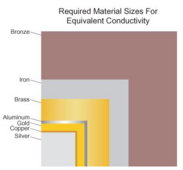I know copper is much better. I made a mistake. I bought a bus bar set to connect two battery packs to my inverter, I thought someone here had bought this one before and said it worked well, but maybe they bought one that looked like it but this was the cheap brass knockoff. Anyhow, I bought it a long time ago.
I was stupider 2 years ago, OK?
No, I don't have it all set up yet... thought we were moving so I held off, then we weren't, then life happened, another kid came, something else big needed fixed on the house, then we were looking for property again, then interest rates, then then etc etc... OK enough excuses. Thankfully we've had stable grid so my grid tie has been fine and we haven't need the batteries.
Anyway, I've been back on the process of setting things up. I'm on the fence between replace these before I even install, or just going with them and seeing how terrible they really are. Running an Outback Radian 8048A.
The other question is, if I replace them, I'll get something with more terminal capacity. Between the dual inputs on the inverter and two battery banks I'd fill a 4 lug bar, so if I ever add batteries (which I will if we do ever move to a different property, not doing a full out grid tie again), I'd need more space. Was thinking something like two of these : https://www.amazon.com/GOUNENGNAIL-25-Copper-Terminal-Positions-Grounding/dp/B08PYBNYKV
But being advertised as "grounding" bus bars, there's no covers. Anyone use something like this and fab your own cover somehow? I just don't want any short circuit risks, and I don't want to just slap electrical tape over it hah.
I can get a bus bar set with covers for more money, but the price is significantly higher for just adding a little more of a pretty appearance and a cover. Example: https://www.amazon.com/jamgoer-Distribution-Terminal-Battery-Automotive/dp/B0BNHST9NP
I was stupider 2 years ago, OK?
No, I don't have it all set up yet... thought we were moving so I held off, then we weren't, then life happened, another kid came, something else big needed fixed on the house, then we were looking for property again, then interest rates, then then etc etc... OK enough excuses. Thankfully we've had stable grid so my grid tie has been fine and we haven't need the batteries.
Anyway, I've been back on the process of setting things up. I'm on the fence between replace these before I even install, or just going with them and seeing how terrible they really are. Running an Outback Radian 8048A.
The other question is, if I replace them, I'll get something with more terminal capacity. Between the dual inputs on the inverter and two battery banks I'd fill a 4 lug bar, so if I ever add batteries (which I will if we do ever move to a different property, not doing a full out grid tie again), I'd need more space. Was thinking something like two of these : https://www.amazon.com/GOUNENGNAIL-25-Copper-Terminal-Positions-Grounding/dp/B08PYBNYKV
But being advertised as "grounding" bus bars, there's no covers. Anyone use something like this and fab your own cover somehow? I just don't want any short circuit risks, and I don't want to just slap electrical tape over it hah.
I can get a bus bar set with covers for more money, but the price is significantly higher for just adding a little more of a pretty appearance and a cover. Example: https://www.amazon.com/jamgoer-Distribution-Terminal-Battery-Automotive/dp/B0BNHST9NP



